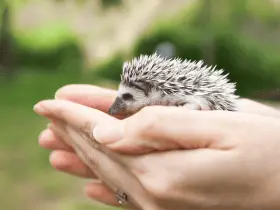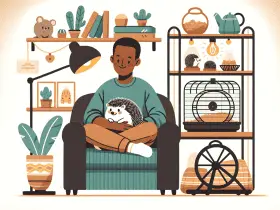Are you curious about hedgehogs and their mysterious body language? Well, look no further! In this article, we’ll dive deep into the fascinating world of hedgehog communication.
We’ll uncover the secrets behind their happiness, fear, and curiosity. By understanding their body language cues, you’ll be able to decode what your little spiky friend is feeling.
So join us as we embark on a journey to unravel the hidden messages in every twitch of their quills and flicker of their eyes. Let’s become fluent in hedgehog-speak together!
Key Takeaways
- Hedgehogs use body signals to communicate their emotions, including happiness, fear, anxiety, and curiosity.
- Signs of happiness in hedgehogs include a relaxed body posture, curling up into a ball or stretching out comfortably, purring sounds, and individual expressions of happiness.
- Hedgehogs exhibit fear and anxiety through behaviors such as curling into a tight ball, hissing, puffing up, raised quills, and hind legs, excessive quilling, hissing, clicking sounds, or attempting to bite. Creating a quiet and peaceful environment and slowly introducing new experiences and handling can help calm them.
- Signs of curiosity in hedgehogs include an erect posture with raised quills, tilting their head, sniffing or nudging objects, becoming more active and energetic, and making soft chirping sounds or clicking noises.
The Basics of Hedgehog Body Language
Hedgehogs use various body signals to communicate their emotions. Understanding hedgehog body language is crucial for pet owners to ensure their furry friends are content and well-cared for. One important aspect of hedgehog body language is the importance of socialization. Hedgehogs are naturally solitary creatures, but they still need regular interaction with humans to feel secure and loved.
Spending time with your pet hedgehog, talking softly to them, and gently handling them can help build a strong bond. When it comes to bonding with your pet hedgehog, observing their body language is key. A happy hedgehog will have relaxed quills that lie flat against their back while they explore their surroundings or interact with you. They may also exhibit a calm demeanor and show interest in exploring new objects or scents in their environment.
On the other hand, a scared hedgehog might curl into a tight ball and tuck its head under its quills as a defense mechanism. They may also hiss or make clicking sounds when feeling threatened or anxious. Lastly, a curious hedgehog will display alertness by raising its head slightly and using its nose to investigate interesting smells or objects.
Signs of a Happy Hedgehog
To recognize when your pet is feeling joyful, pay attention to their relaxed body posture and the contented purring sound they make. Understanding hedgehog body language is crucial for interpreting their emotions and forming a strong bond with them.
Hedgehogs communicate primarily through their body language, so being able to interpret these signals will help you understand how they are feeling.
A happy hedgehog will have a relaxed body posture, with their spines lying flat against their back. They may also curl up into a ball or stretch out comfortably when they are content. Another sign of happiness in hedgehogs is the purring sound they make, which is similar to that of a cat. This soft and gentle noise indicates that they are enjoying themselves and feel safe in their environment.
It’s important to note that each hedgehog may have slightly different expressions of happiness, so it’s essential to observe your pet’s specific behaviors and cues. By paying attention to their body language and listening for the purring sound, you can ensure that your hedgehog feels loved and secure in its surroundings.
How to Recognize Fear in Hedgehogs
When it comes to hedgehogs, it’s important to be able to recognize signs of fear and anxiety. These small creatures may exhibit certain behaviors or body language cues that indicate they are feeling scared or anxious.
Fear Signs in Hedgehogs
Don’t miss the signs that your hedgehog is scared! It’s important to understand how our prickly friends express fear so we can create a safe and comfortable environment for them.
When a hedgehog is scared, they may exhibit certain behaviors and body language cues. One common sign of fear in hedgehogs is curling into a tight ball with their spines extended. They may also hiss, puff up, or make clicking noises. Raised quills along the back and raised hind legs are also indicators of fear.
Common causes of fear in hedgehogs include loud noises, sudden movements, unfamiliar scents, or being handled roughly. By recognizing these signs and addressing their underlying causes, we can help our hedgehogs feel secure and happy in their surroundings.
Identifying Hedgehog Anxiety
Recognizing the signs of anxiety in hedgehogs can help us better understand their needs and provide a calming environment. Hedgehogs, like humans, experience stress triggers that can cause them to feel anxious. These triggers include loud noises, sudden movements, unfamiliar environments, and handling by unfamiliar people.
When a hedgehog is anxious, it may display certain behaviors such as excessive quilling (raising its spines), curling into a tight ball, hissing or clicking sounds, or even attempting to bite.
To calm an anxious hedgehog, there are several techniques we can employ. Creating a quiet and peaceful environment with minimal disturbances can help alleviate their anxiety. Providing hiding spots or tunnels in their enclosure allows them to retreat when they feel overwhelmed. Slowly introducing new experiences and handling will also help them become more comfortable over time.
Understanding Curiosity in Hedgehogs
You can tell when a hedgehog is curious by observing its body language and behavior. Hedgehogs have unique exploration habits that allow them to engage with new stimuli in their environment. When a hedgehog is curious, it will often exhibit certain behaviors that indicate its interest and desire for exploration.
One of the most noticeable signs of curiosity in a hedgehog is an erect posture. When they are alert and interested in something, their quills stand up straight, making them appear larger than usual. They may also tilt their head slightly to get a better view of what has caught their attention.
Curious hedgehogs will often approach new stimuli cautiously but with a sense of purpose. They may use their snout to sniff or nudge at objects, trying to gain more information about them. Their small, beady eyes will be focused on the object as they carefully investigate it.
In addition to physical cues, you can also observe behavioral changes in curious hedgehogs. They may become more active and energetic, running around or even jumping in excitement. Curious hedgehogs are also known to make soft chirping sounds or clicking noises as they explore.
Understanding these exploration habits and the ways in which hedgehogs engage with new stimuli can help us create enriching environments for them where they feel safe and stimulated. By providing opportunities for curiosity-driven exploration, we can promote their natural instincts and enhance their overall well-being.
Body Language Cues for Contentment in Hedgehogs
To understand how a hedgehog is feeling, pay attention to its body language cues for contentment. Hedgehogs may seem prickly and unapproachable, but they have their ways of showing us that they are happy and at ease.
When a hedgehog is content, it will often relax its quills, which normally stand erect when it feels threatened or scared. Its body will appear loose and relaxed, with no signs of tension. The hedgehog may also curl up into a tight ball, tucking its head underneath its spines as if in a peaceful slumber.
Another indicator of contentment in hedgehogs is their behavior towards humans and their surroundings. Happy hedgehogs will exhibit exploratory behaviors such as sniffing around or investigating objects with their noses. They may also engage in play by rolling on their backs or frolicking with toys.
When decoding hedgehog emotions through body language cues for contentment, it is essential to approach them gently and observe them from a distance initially. Respect their personal space and allow them to come to you when they feel comfortable.
Identifying Stress and Anxiety in Hedgehogs
Now that we’ve learned about the body language cues for contentment in hedgehogs, let’s shift our focus to identifying signs of stress and anxiety in these adorable creatures. It’s important to understand when our hedgehog friends are feeling overwhelmed or uncomfortable so that we can take steps to help them feel more at ease.
One of the common signs of stress in hedgehogs is excessive quilling, which is the shedding of their spines. If you notice an unusually large number of quills around their enclosure, it might indicate that your hedgehog is experiencing heightened anxiety. Another telltale sign is excessive scratching or biting, as this behavior can be a way for them to cope with stress.
To reduce anxiety in hedgehogs, there are several tips you can follow. First and foremost, create a calm and quiet environment for your pet by providing a cozy hideout where they can retreat when they feel overwhelmed. Additionally, make sure their enclosure is clean and well-maintained to minimize any potential sources of stress.
Regular handling and socialization also play crucial roles in reducing anxiety in hedgehogs. Gradually introduce new experiences and people into their lives to help them become more comfortable with different environments and individuals.
The Role of Ears and Eyes in Hedgehog Communication
The role of ears and eyes is essential in hedgehog communication. We use these body parts to convey various emotions and intentions. Understanding hedgehog ear positions and eye behavior can help us interpret their feelings and needs.
When a hedgehog’s ears are standing upright, it indicates that they are alert and attentive. This position shows that they are curious about their surroundings or focused on something specific. On the other hand, flattened ears suggest fear or aggression. If you see a hedgehog with its ears positioned back against its head, it may be feeling threatened or defensive.
Similarly, observing a hedgehog’s eye behavior can provide valuable insights into their emotional state. Hedgehogs typically have small eyes, but when they widen them and maintain eye contact with you or another animal, it signifies curiosity or interest. It also shows trust and engagement in communication.
Eye contact plays a crucial role in hedgehog communication. It helps them establish social bonds with humans and other animals. When a hedgehog maintains consistent eye contact while being handled or interacted with, it demonstrates comfort and familiarity.
Interpreting ear movements in hedgehogs is an important skill for understanding their needs. By paying attention to their ear positions and combining that knowledge with observations of their eye behavior, we can better communicate with our spiky friends and ensure their well-being within our shared environment.
Deciphering Hedgehog Vocalizations
When it comes to understanding hedgehog communication, one key aspect to consider is their vocal cues. Hedgehogs use a variety of sounds and noises to express themselves and convey different messages.
By deciphering these vocalizations, we can gain valuable insights into their behavior, emotions, and needs.
In this discussion, we will explore the different types of hedgehog vocal cues and how they contribute to our overall understanding of hedgehog communication.
Hedgehog Vocal Cues
Hedgehogs can use vocal cues to communicate their feelings. These unique sounds provide valuable insights into their emotions and needs. By interpreting hedgehog vocalizations, we can better understand our prickly companions and create a stronger bond with them.
Purring: When a hedgehog purrs, it generally indicates contentment and relaxation. It’s like their way of saying ‘I’m happy.’
Hissing: If you hear a hissing sound, it means your hedgehog is feeling defensive or threatened. They are trying to protect themselves.
Clicking: Clicking noises often occur when a hedgehog is exploring or curious about something new in its environment.
Whining: Hedgehogs may whine when they are uncomfortable or seeking attention. It’s their way of expressing dissatisfaction.
Barking: Yes, some hedgehogs bark! This high-pitched noise typically signals fear or distress.
Understanding these vocal cues allows us to respond appropriately to our hedgehogs’ needs and ensure their well-being. So next time you hear your little friend making strange sounds, take a moment to interpret what they’re trying to tell you.
Understanding Hedgehog Communication
Understanding hedgehog vocal cues can help us build a stronger bond with our prickly companions and ensure their well-being. However, it’s important to note that hedgehogs are not known for being particularly vocal animals. They communicate primarily through body language, which includes various postures, movements, and sounds. When it comes to hedgehog playtime and socialization, observing their behavior is key.
During playtime, happy hedgehogs may display signs of excitement such as running around energetically or exploring their surroundings with curiosity. They might also emit soft chirping sounds or purring noises as a sign of contentment. On the other hand, if a hedgie feels scared or threatened during socialization, they may curl up into a tight ball, hiss loudly in an attempt to scare off potential threats or predators.
Reading Hedgehog Facial Expressions
Take note of how your hedgehog’s facial expressions can provide insight into their emotions. Understanding hedgehog facial expressions is essential for interpreting their emotions accurately.
Here are some key indicators to look out for:
Eyes: Pay attention to the size and shape of your hedgehog’s eyes. Wide-open eyes indicate alertness and curiosity, while squinted or closed eyes may suggest contentment or sleepiness.
Ears: Hedgehogs use their ears to express various emotions. When their ears are relaxed and facing forward, it means they are calm and comfortable. However, if their ears are flattened against their head, it could indicate fear or aggression.
Mouth: Observe the position of your hedgehog’s mouth. A slightly open mouth with a relaxed expression usually indicates comfort and relaxation. On the other hand, a tightly closed mouth can be a sign of stress or anxiety.
Nose: The nose can also reveal important cues about your hedgehog’s emotions. A moist nose typically shows good health and well-being, while a dry or crusty nose might require attention from a veterinarian.
Whiskers: Keep an eye on your hedgehog’s whiskers as they provide clues about their mood. When the whiskers are positioned forward and relaxed, it signifies calmness; however, if they’re pulled back tightly against the face, it could mean fear or discomfort.
Behavioral Patterns That Indicate Different Emotions in Hedgehogs
Pay attention to the various behavioral patterns exhibited by your hedgehog as they can indicate different emotions. As responsible hedgehog owners, it’s important for us to understand and interpret these behaviors in order to provide a safe and nurturing environment for our beloved pets.
One of the signs of discomfort in hedgehogs is excessive quilling. When a hedgehog feels anxious or stressed, they may start shedding their quills more frequently than usual. This behavior is often accompanied by huffing, puffing, and curling into a tight ball.
To calm an anxious hedgehog, it’s essential to create a peaceful and soothing environment. Providing them with a quiet space where they can retreat when feeling overwhelmed can help alleviate their anxiety. Additionally, maintaining consistent routines and avoiding sudden changes can also contribute to their overall sense of security.
Another common behavioral pattern that indicates distress in hedgehogs is excessive scratching or biting at themselves. This could be a sign of skin irritation or mites, which require immediate veterinary attention.
Frequently Asked Questions
What Are the Common Health Issues That Can Affect a Hedgehog’s Body Language?
Hedgehog health issues can affect their body language. Signs of loneliness or boredom in hedgehogs include decreased activity and appetite, excessive sleeping, and self-destructive behavior. It’s important to monitor their behavior for any potential health concerns.
How Can I Tell if My Hedgehog Is Feeling Lonely or Bored?
When hedgehogs are feeling lonely or bored, they may exhibit signs such as excessive sleeping, lack of appetite, and decreased activity. To keep them entertained, provide stimulating toys, regular interaction, and a comfortable environment.
Are There Any Specific Body Language Cues That Indicate a Hedgehog Is in Pain or Discomfort?
There are specific body language cues that indicate hedgehog pain or discomfort. By observing their behavior and physical signs, such as hunching, loss of appetite, and quill standing, we can understand their well-being.
What Are Some Ways to Help a Scared or Anxious Hedgehog Feel More Comfortable and Secure?
Creating a safe environment includes setting up hiding spots and maintaining proper temperature. Slow, gentle socialization by gradually introducing them to new people and environments helps hedgehogs feel more comfortable and secure.
Can Hedgehogs Communicate With Each Other Using Their Body Language?
Yes, hedgehogs can use body language to communicate with each other and understand each other’s emotions. Body language plays a crucial role in hedgehog communication, allowing them to establish social bonds and convey their feelings effectively.
Conclusion
In conclusion, understanding hedgehog body language is key to deciphering their emotions and needs. By observing their behavior, we can determine whether they’re happy, scared, or curious. From the position of their quills to the movement of their ears and eyes, every cue plays a role in hedgehog communication.
Additionally, vocalizations and facial expressions further reveal their emotional state. So next time you interact with a hedgehog, ask yourself: Can you decode their body language?















Leave a Reply
View Comments